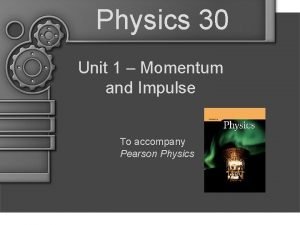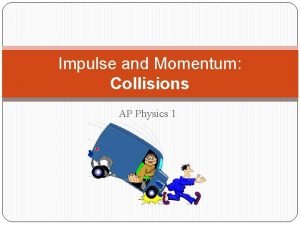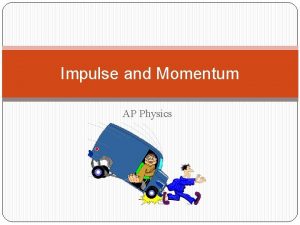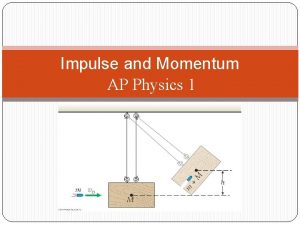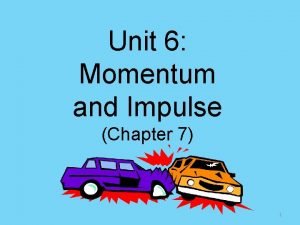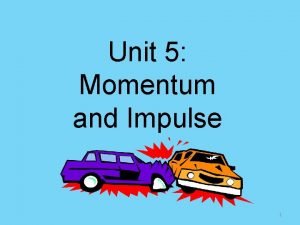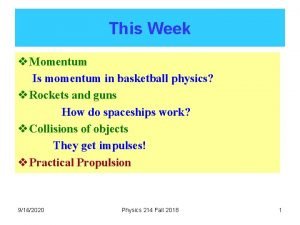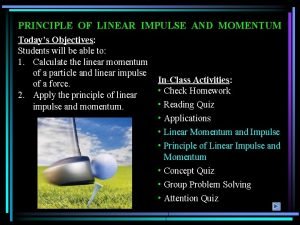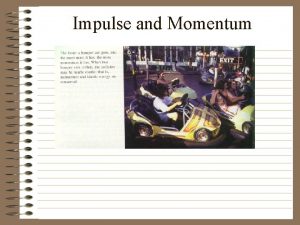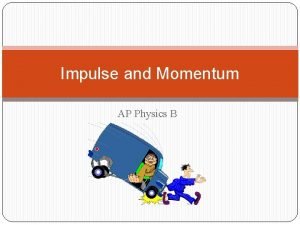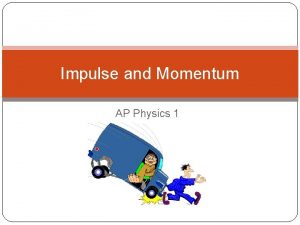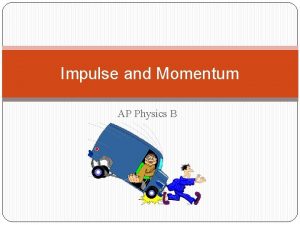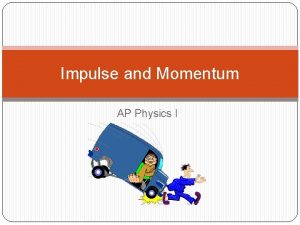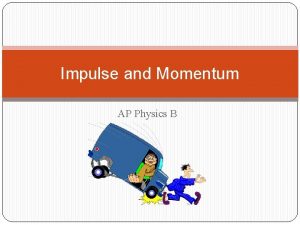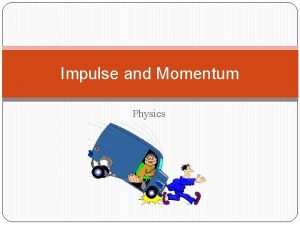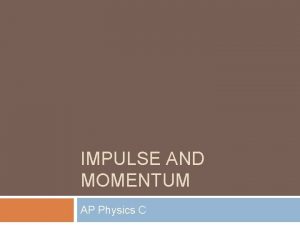Physics 101 Lecture 11 Momentum and Impulse Physics













- Slides: 13

Physics 101: Lecture 11 Momentum and Impulse Physics 101: Lecture 11, Pg 1

Key Ideas l Last Time: Work-Energy ØS F = m a multiply both sides by d ØS F d= m a d (note a d = ½ Dv 2) ØS F d= ½ m Dv 2 ØS W = DKE Define Work and Kinetic Energy l This Time: Impulse-Momentum ØS F = m a multiply both sides by Dt ØS F Dt= m a Dt (note a Dt = Dv) ØS F Dt= m Dv ØS I = Dp Define Impulse and Momentum Physics 101: Lecture 11, Pg 2 08

Demo/Example Two identical balls are dropped from the same height onto the floor. In each case they have velocity v downward just before hitting the floor. In case 1 the ball bounces back up, and in case 2 the ball sticks to the floor without bouncing. In which case is the magnitude of the impulse given to the ball by the floor the biggest? A. Case 1 B. Case 2 Bouncing Ball Sticky Ball C. The same Physics 101: Lecture 11, Pg 3 16

Question In both cases of the above question, the direction of the impulse given to the ball by the floor is the same. What is this direction? A. Upward B. Downward time Physics 101: Lecture 11, Pg 4 19

Demo You throw an egg into 1) A sheet In both cases, the egg stops. 2) A wall In which case is the impulse greater? A) Sheet B) Wall C) the same I = DP Same change in momentum In which case is the average force greater A) Sheet B) Wall C) the same Dp = F Dt F = Dp/Dt Smaller Dt = large F Physics 101: Lecture 11, Pg 5 24

m = 1500 kg Example: stopping car Vo=40 m/s How long does it take the car to stop? µs = 0. 6 Physics 101: Lecture 11, Pg 6

Momentum is Conserved l Momentum is “Conserved” meaning it can not be created nor destroyed ØCan be transferred l Total Momentum does not change with time. l. This is a BIG deal! Physics 101: Lecture 11, Pg 7 30

Example: collision “before” Vo = 0 m/s Vo = 5 m/s M 1=2 kg M 2=3 kg “after” M 1=2 kg M 2=3 kg Two blocks collide and stick together, what is their final velocity? Physics 101: Lecture 11, Pg 8

Example: collision “before” Vo = 2 m/s Vo = 5 m/s M 1=2 kg M 2=3 kg “after” M 1=2 kg M 2=3 kg Two blocks collide and stick together, what is their final velocity? Physics 101: Lecture 11, Pg 9

Example: cannon (explosion) mc = 200 kg mb = 5 kg What is the velocity of the cannon? v = 300 m/s Physics 101: Lecture 11, Pg 10

Explosions A=1, B=2, C=same “before” M v 1 m 2 v 2 “after” • Example: m 1 = M/3 m 2 = 2 M/3 • Which block has larger |momentum|? 0 = p 1+p 2 p 1= -p 2 * Each has same |momentum| • Which block has larger speed? * mv same for each smaller mass has larger velocity • Which block has larger kinetic energy? * KE = mv 2/2 = m 2 v 2/2 m = p 2/2 m * smaller mass has larger KE • Is mechanical (kinetic) energy conserved? * NO!! Physics 101: Lecture 11, Pg 1135

Impulse and Momentum Summary Ø Collisions and Explosions ØDraw “before”, “after” ØDefine system so that Fext = 0 ØSet up axes ØCompute Ptotal “before” ØCompute Ptotal “after” ØSet them equal to each other Physics 101: Lecture 11, Pg 12 33

Summary ØImpulse I = FDt » Gives change in momentum I = Dp ØMomentum p = mv » Momentum is VECTOR » Momentum is conserved (when SF = 0) n S mvinitial = S mvfinal Physics 101: Lecture 11, Pg 13 50
 Physics 03-06 impulse and momentum answer key
Physics 03-06 impulse and momentum answer key Physics 30 momentum and impulse unit exam
Physics 30 momentum and impulse unit exam Ap physics momentum and impulse
Ap physics momentum and impulse Units of impulse
Units of impulse Impulsive force
Impulsive force What is momentum in physics
What is momentum in physics What is a harmonic wave in physics
What is a harmonic wave in physics Phy101 lecture 1
Phy101 lecture 1 Physics 101 lecture notes pdf
Physics 101 lecture notes pdf Waves notes pdf download
Waves notes pdf download Unit 6 momentum and impulse
Unit 6 momentum and impulse Units of momentum
Units of momentum How to find initial momentum
How to find initial momentum Linear impulse momentum equation
Linear impulse momentum equation

